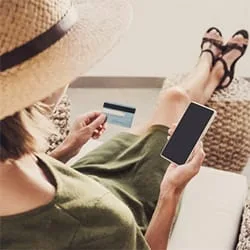Having your money stolen is right up there with flight delays and lost luggage when it comes to travel risks. But even if you’re going somewhere that has a reputation for pickpocketing, there are ways you can keep your money and other valuables secure against theft or loss.
To help you get peace of mind on your next trip, we look at the different types of travel money available along with ways to securely carry it when you go abroad.
What travel money options are available?
Before you head off on your trip, it’s worth considering the different ways you can take money with you. Here’s a rundown of the most popular options:
- Foreign cash. Getting cash in the currency of your destination gives you a way to make payments even if cards are not accepted. It’s also useful for smaller payments and for tipping (if you’re in a country where that’s expected).
- Travel cards. Travel cards let you load and spend money in a range of different currencies. This means you can lock in your funds before you go and avoid international transaction fees that are commonly charged by credit cards and debit cards.
- Credit cards. Credit cards give you access to a set amount of money when you’re away and may come with added perks such as airport lounge access or travel insurance. But keep in mind that many credit cards charge an international transaction fee when you make payments in another currency, as well as cash advance rates and fees if you use one to withdraw money from an ATM.
- Debit cards. If you want to spend money directly from your bank account, you could take your everyday Visa or MasterCard debit card with you when you go overseas. Just be aware that the currency will be exchanged at the daily rate for that card and will usually attract an international transaction fee.
Compare travel money options in detail here
What is the best way to carry money while travelling overseas?
 There are many different ways you can carry your travel money around, each with its own pros and cons, depending on where you’re travelling, what you’ll be doing, the type of travel money you’re taking and your own personal preferences. So instead of telling you there’s one “best” way to carry money around when you’re travelling, you can compare six popular options here, to find what works for you.
There are many different ways you can carry your travel money around, each with its own pros and cons, depending on where you’re travelling, what you’ll be doing, the type of travel money you’re taking and your own personal preferences. So instead of telling you there’s one “best” way to carry money around when you’re travelling, you can compare six popular options here, to find what works for you.
1. Split it up
Most travellers take a combination of cash and cards with them when they go overseas. Instead of keeping them all in your wallet, you could choose to put them in different parts of your luggage.
For example, you could have your cash in a secure part of your everyday travel bag or backpack and put your credit card in a pocket of your shirt or jacket. That way, if something happens to one of these forms of currency, you’ll have the other to get you by.
2. Set up payments on your smartwatch
If you have an Apple Watch, Samsung Gear or any other smartwatch that offers mobile payments, you could literally wear your money when you travel. Just set up the payment app before you go and tap to pay at any overseas terminal where contactless payments are accepted.
With most smartwatches looking like chunky versions of a regular watch, potential thieves may not even realize that’s where you’re keeping your money. There are also a number of travel apps designed especially for your smartwatch, which means you could use it for language transaction, navigation and directions — or even for keeping track of flight changes. Plus, you’ll be able to tell the time wherever you are! Just remember that some countries and locations may not have many (or any) contactless payment terminals, so you may need to have cash and cards on hand just in case.
3. Go high-tech with wearables
Don’t feel like investing in a bulky smartwatch? Another option is to get a discreet wearable payment device like the McLEAR wearable payment ring, which links to an eligible bank card for easy contactless payments from the tip of your finger (quite literally).
Another option is Manage-Mii by DIGISEQ. This can be worn as a ring, bracelet or key fob and can even hide in the cuff of your shirt. Manage-Mii connects to your Mastercard and blends in with your outfit as a fashion accessory.
Smartwatches and wearables tend to be a pricier payment method in comparison to carrying around your bank card, with most starting from £60+. However, they reduce the risk of your bank card getting lost or stolen and help you to feel a little more secure during your travels.
Before you jet off to your next destination, it’s always a good idea to research where you’re going so you know how common (or uncommon) contactless payment options could be – just in case a wearable isn’t the best option for you.

4. Get creative with your “wallet”
Whether it’s in your hand or your bag, a wallet or purse could act as a beacon for thieves. It’s easily identifiable and probably the first (and only) thing they’ll look for when trying to swindle you.
So what can you do about it? One option is to travel with a decoy wallet — an everyday, cheap wallet that you fill with some random bits of paper or generic cards and can throw away if need be. Another option is to use something unexpected as a wallet while you travel.
For example, you could use a small makeup bag for both cash and cards, while a reusable plastic or stainless steel drink bottle could be used for cash. Other options could be toiletry containers (as long as they’re not clear), cigarette cases or old pill bottles. Any of these could work as camouflage for your money when you’re out sightseeing, relaxing at the beach or chilling at a café. Because really, who is going to think to steal your makeup or water?
5. Wear a money belt
This is an oldie but a goodie when it comes to keeping currency and even your passport safe when you travel overseas. While money belts don’t exactly sound attractive, they are effective. Just strap it on under your shirt (or a few outer layers if you’re going somewhere cold) and you can walk around knowing your valuables are secured to you.
These days, there is also a wide range of money belts with sleek designs and comfortable features. The only downside is that if you want to make a payment, it could be tricky to get your cash or cards out in a store. Then again, that’s another reason not to store all your currency in one place when you’re travelling.
6. Use hidden pockets
Pockets on the inside of a jacket or pair of pants could be enough to stop even the lightest fingers from getting at your money. There’s a wide variety of fashionable clothes offering hidden pockets and compartments where you could store cash and cards when you travel.
Winter jackets and parkas are particularly popular options, but you can even find some activewear that has a hidden or zippered section that fits a card or two. Or, if you’re handy with a sewing machine, you could even add a few inside pockets to your clothes before you go overseas.
Whether you’re backpacking through a remote rainforest or enjoying the bright lights of a city, losing your money when travelling is a risk that has no borders. But making use of any of these six strategies can help keep your money safe so you can enjoy your overseas adventures.
Pictures: Shutterstock
More guides on Finder
-
Best ways to spend travel money in Colombia
Learn more about your options for spending travel money in Colombia.
-
Best ways to spend travel money in Belgium
Discover the best ways to spend travel money in Belgium.
-
Best ways to spend travel money in Fiji
Discover the best ways to spend travel money in Fiji.
-
Post Office Travel Money Card review
Get a multi-currency card instantly by visiting a Post Office branch, but watch out for the fees.
-
Barclays Travel Wallet Review
Find out how the Barclays Travel Wallet could save you money when spending overseas.
-
HSBC Global Money Account review
Store multiple currencies and enjoy fee-free spending while abroad with HSBC’s Global Money account.
-
Opening a bank account in Singapore
Learn more about opening a bank account in Singapore as a foreigner.
-
Currensea review
Here’s all you need to know about the travel debit card that wants to make travelling and spending money abroad hassle free.
-
Prepaid travel cards
Taking a travel card is less stressful than taking a regular bank card and there’s also savings to be had. Find out if a prepaid travel card is right for you before booking your trip abroad.
-
Best way to spend money in USA: Best cards to use
The USA has a culture of credit, and it’s a society of card payments, read our travel money guide to find out which travel products to use and which to avoid using in the USA.
